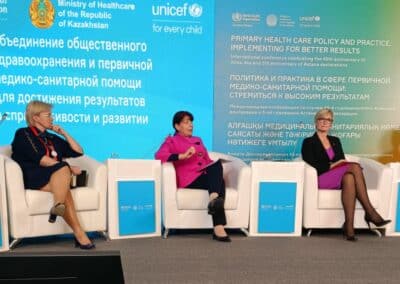Or, what is missing at the intersection of primary health care and public health to drive results and ensure health equity?
As the European Public Health conference 2023 is revving up its engines in Dublin, I am looking back to the week in Astana. In addition to the intense learnings from the 73rd Regional Committee Meeting of the WHO Regional Office for Europe, the week was marked by the amazing International Primary Health Care Conference co-organised by the WHO Europe and UNICEF.
In a dynamic plenary session on “Synergizing Public Health and Primary Health Care to Drive Results for Equity and Development” skilfully moderated by Antoni Dedeu of WHO Europe and Caroline Costongs of EuroHealthNet, successful, hands-on examples of primary health care were shared from four different WHO regions, from small and big countries, from global north and global south. They included those from Lithuania by Danguole Jankauskiene, Slovenia by Vesna Kerstin Petrič, Iran by Hossein Farshidi, Sri Lanka by Garusinge Wijesuriya, and Brazil by Felipe Proenco, highlighting the benefits of multidisciplinary and cross-sectoral approaches in delivering PHC, as well as the critical importance of:
- focusing on prevention
- adjusting to specific contexts and circumstances, and
- (humbly) working with local communities to understand the specific needs and deliver PHC to the most vulnerable.
I was asked for a bird-eye view on what’s missing at the intersection between primary health care (PHC) and public health to make them deliver better to the most vulnerable. Below I share some of the thoughts I brought to that discussion.
Forty five years old, the visionary and inspiring Alma-Ata Declaration that called for focus on PHC as the key to achieving an acceptable level of health throughout the world, stood the test of time. So much so, that four decades later, in 2018, in time for Astana Declaration, it needed a mere refreshment rather than a revision. Fast forward five more years, and we can not but admire the major health successes of the past five decades, from higher life expectancy, over improved maternal and child health, better immunisation and nutrition, all the way to communicable diseases no longer being the leading cause of death in the world.
The challenges, however, remain many and complex. The rise in non-communicable diseases, the looming AMR crisis, climate change, cost of living crisis keep incessantly pressing on health and wellbeing of people across the world, and on the health systems irrespective of country that we live in. We still find ourselves having to fight for health as a fundamental human right. And we still – shockingly! – find ourselves investing in wars and destruction instead of in health and equity.
In such pressing conditions, the PHC remains the most inclusive, equitable, cost-effective and efficient approach to enhance people’s physical and mental health and wellbeing. The examples from five countries highlight that in delivering it, there is no silver bullet and no single size fits all. We must be creative, agile and flexible in finding the best solutions for our local and regional contexts and challenges.
We must, however, also acknowledge the whole range of non-medical factors – social, environmental, political, commercial – that shape our environments and influence our health, that affect disproportionately most vulnerable among us, and that cannot be counterbalanced by the improved health services no matter how hard we try. To illustrate this, products on our internal markets (including tobacco, alcohol, unhealthy food and beverages), quality of air we breathe and water we drink, transport, urban and natural environment, they all directly impact our physical and mental health and wellbeing. These determinants of health also cause most of the burden of disease, bear the majority of health costs, and are at the core of health inequity – the key concern for both the PHC and public health.
However, it is only the downstream effects of the impact of the determinants of health that can be modified through changes in our health systems. The root causes of that impact must be addressed upstream, outside of the health systems. In fact, the only way to future proof our health systems and preserve them from collapsing, is to act upstream, directly on the health determinants, ensuring the so-called primordial prevention.
Acting on determinants of health comes with its own challenges, way beyond what can be tackled by PHC, public health or health systems approaches. Solving such complex issues takes a determined systems approach and all the stakeholders on board. Most of all, it takes political will and courage (a precious and rare commodity nowadays) to put people above profit. This, again, takes a tectonic shift in our current economic and political systems that are solely driven by growth economy.
This shift is not impossible however, as – pressed by unprecedented existential crises – we might be getting close to the social tipping point that will help secure the change we need. To help tip the needle, we all, regardless of the positions and sectors we are in, must bring our (public) health advocacy to the whole new level. We all must turn into (Public) Health Advocates 2.0, and act with an utter sense of urgency in the interest of people and planet.
Dr Milka Sokolović, Director General, EPHA


